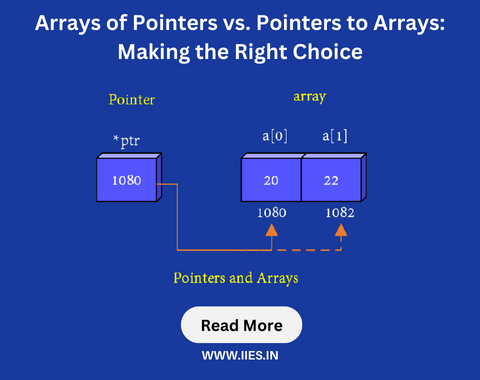
Pointers and arrays are fundamental concepts in programming. A pointer is a variable that stores a memory address, while an array is a collection of similar type variables stored in contiguous memory locations. Pointers and arrays can be used together for various programming situations.
It is crucial to understand the differences between arrays of pointers and pointers to arrays. Arrays of pointers are arrays where each element is a pointer to another variable or array. Pointers to arrays, on the other hand, are pointers that point to the first element of an array.
This blog post explores the differences, benefits, and drawbacks of arrays of pointers vs. pointers to arrays, as well as the factors influencing the choice, best practices, and real-world examples.
Both pointers and arrays are used to store and manipulate data in memory. Pointers are variables that hold memory addresses, and arrays are collections of similar type variables stored in contiguous memory locations.
Arrays are often represented by a single name, while pointer variables are assigned a memory address using the ampersand (&) operator. Pointer variables are dereferenced using the asterisk (*) operator to access the value stored in the memory address they point to.
Arrays of pointers are arrays where each element is a pointer to another variable or array. They provide flexibility and adaptability in different programming scenarios, such as dynamic 2D arrays or strings of varying lengths.
When working with sophisticated data structures like linked lists, trees, or graphs, arrays of pointers can be quite handy. They enable efficient traversal and manipulation of these structures and make it easier to work with dynamic data that changes over time.
However, arrays of pointers are more complex than regular arrays, can be challenging to manage, and require more memory space to store both pointers and data.
Pointers to arrays are pointers that point to the first element of an array. They are used to pass arrays to functions efficiently and effectively and perform array arithmetic operations.
Pointers to arrays are beneficial for large data structures that can exceed memory capacity, as they allow data to be accessed and manipulated more efficiently. They also provide flexibility in function calls and reduce the overhead of copying arrays.
However, pointers to arrays can be less flexible than arrays of pointers, and managing complex array operations can be challenging.
Arrays of pointers and pointers to arrays have key differences in memory allocation and storage, accessing elements and their memory layout, pointer arithmetic implications, and flexibility and adaptability in different programming scenarios.
Arrays of pointers store pointers to individual memory locations, while pointers to arrays point to the first element of the array. This difference affects the memory layout and allocation of data.
Arrays of pointers provide better data manipulation and flexibility in complex data structures, while pointers to arrays provide better memory optimization and performance.
The choice between arrays of pointers and pointers to arrays depends on the nature of the problem and data structure requirements, performance considerations, code readability and maintainability, and common programming practices and design patterns.
It is essential to carefully consider these factors when choosing between arrays of pointers and pointers to arrays to ensure optimal performance and maintainability.
Guidelines for choosing between arrays of pointers and pointers to arrays include considering memory allocation and storage requirements, accessing elements and their memory layout, pointer arithmetic implications, and flexibility and adaptability in different programming scenarios.
It is also important to optimize code when using either approach, such as using the const keyword to prevent accidental modification of data and avoiding excessively complex data structures.
Real-world examples of using arrays of pointers and pointers to arrays include managing a list of students and their courses using arrays of pointers and implementing a matrix library with pointers to arrays for efficient calculations.
Arrays of pointers and pointers to arrays are fundamental concepts in programming that provide flexibility and optimize memory and performance in different programming scenarios. Understanding the differences, benefits, and drawbacks of each approach and considering the factors influencing the choice can ensure optimal performance, maintainability, and flexibility in programming.
Must Read: The Evolution of AI: From Simple Algorithms to Machine Learning and Beyond
Indian Institute of Embedded Systems – IIES